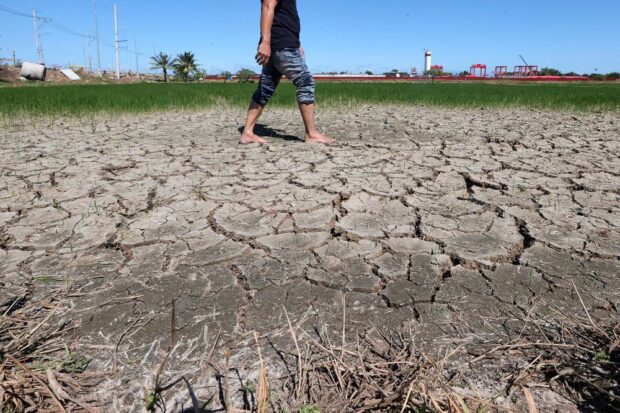Task force: El Niño seen to spare only 2 provinces

WAITING FOR A DROP | Farms, like ricefields in Bulacan province, are starting to dry up due to the absence of heavy rains and a shortage of irrigation water. A government task force says 80 of the country’s 82 provinces will feel the impact of the El Niño weather phenomenon in varying degrees until June. (File photo by GRIG C. MONTEGRANDE / Philippine Daily Inquirer)
MANILA, Philippines — The effects of strong El Niño will impact up to 80 of the country’s 82 provinces which may persist until June, an official of the multiagency task force said on Wednesday.
Communications Assistant Secretary Joey Villarama, spokesperson for Task Force El Niño, said the impact of water shortage had begun to be felt in two more regions this week, with farmers reporting damage to their dried-up farmlands.
“The last time I [presented a report], I mentioned 41 provinces were already affected. As of Feb. 25, this number has gone up to 51, and it is projected to further increase to 73, then up to 80 provinces, before it will again go down to just over 50,” he said.
Villarama announced this just as the National Disaster Risk Reduction and Management Council reported that the prolonged dry spell had damaged an estimated P810 million worth of crops in the country.
He did not identify the only two provinces that will not be impacted by El Niño, but a chart provided by the National Irrigation Administration (NIA) showed that only the island province of Batanes and coastal Sarangani province will be spared its effects.
Article continues after this advertisement“Last week, we received reports of crop damage in Regions 6 (Western Visayas) and 9 (Zamboanga Peninsula); this week, the damage is being reported in Regions 1 (Ilocos) and 4-B or Mimaropa (Mindoro, Marinduque, Romblon and Palawan),” he said.
Article continues after this advertisement
UPLAND BLAZE | Traces of a grass fire are still visible at Villa Verde Trail along the San Nicolas (Pangasinan)-Santa Fe (Nueva Vizcaya) Road in this photo taken on Feb. 18, 2024. Forest fires have been reported in northern Luzon’s mountains since January amid dry conditions accompanying El Niño. (File. photo by WILLIE LOMIBAO / Inquirer Northern Luzon)
Dry spell losses
While crop damage has been reported in Oriental Mindoro and Occidental Mindoro, these are still considered insignificant, Villarama said.
“The projection of NIA is about 275,000 hectares (ha) nationwide will be damaged by El Niño, but at the moment, it is still at 6,600 ha,” he said over the government television program “Bagong Pilipinas Ngayon.”
“But we are not discounting the fact that this will not cause any impact on our harvest because we are still in the early stages of the dry harvest season,” Villarama added.
According to projections of the Department of Agriculture (DA), the worst effect of El Niño will be felt in the country in April, with a total of 80 provinces seen to experience “drought,” “dry spell,” and “dry condition.”
Of these, 41 provinces will experience drought, 31 will be under a dry spell, and eight will have dry conditions, according to the DA.
The Philippine Atmospheric, Geophysical and Astronomical Services Administration (Pagasa) says an area is experiencing drought if rainfall conditions are “way below normal” (more than 60 percent reduction from the average) for three consecutive months or are “below normal” (21 percent to 60 percent reduction from the average) for five consecutive months.
Pagasa says a dry spell is characterized by three consecutive months of below normal or two consecutive months of way below normal rainfall conditions while dry condition occurs during two consecutive months of below normal rainfall.
By May, 40 provinces will still be experiencing drought, consisting of 17 provinces in Luzon, 14 in the Visayas and nine in Mindanao, the DA said.
Nineteen provinces will be under a dry spell, according to the agency’s projections: eight in Luzon, two in the Visayas and nine in Mindanao.
READ: Pagasa: Drought may hit 24 provinces due to El Niño
The effects of El Niño will continue to wane in June, with only 10 provinces still experiencing drought and only one—La Union—having dry conditions, data from the DA showed.
State of calamity
The DA, Villarama said, is calling on local governments in drought-stricken areas to declare their localities under a state of calamity to trigger mechanisms that would allow the government to assist affected farmers.
A declaration of a state of calamity will authorize the national government to tap the quick response fund, he said, which is supposedly used to provide added funds of up to P5,000 for farm inputs, or fuel subsidy.
The Department of Social Welfare and Development, through the Assistance to Indigents in Crisis Situations program, and the Department of Labor and Employment, through its cash-for-work program, may also come to the aid of farmers whose main concern is their daily sustenance, Villarama said.
Such calamity state declaration may also allow the local government to provide cash aid from local funding, he said.